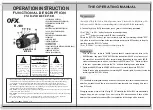
GUIDE TO INSTALLATION AND OPERATION
10
| FXE-1501
4.1.4 Jumbo Packet Size
The use of Jumbo Frames, carrying larger packets of data than the original Ethernet frame of 1518 bytes, can
increase system throughput in some cases. The same frame size must be used at both ends of the network, and
because it is non-standard, it must be set explicitly at each end. The default option here is the standard packet size.
•
Available choices: [1.5 Kb, 2 Kb, 10 Kb]
4.1.5 Link Loss Forwarding
Link Loss Forwarding is a method of flagging loss of signal on the FXE-1501’s fiber input. When signal loss is
detected, the FXE-1501 turns off its UTP transmitter, allowing the device at the other end of the UTP link to be
immediately aware that there is a problem, and for troubleshooting to be initiated. It also turns off its fiber transmitter,
shutting down the return link. The FXE-1501 at the other end of the fiber link will detect that shutdown if its LLF is
enabled, and the entire system will be shut down. Once the failed link is repaired, the LLF will detect the resumption of
signal, and the entire system will go back into normal operation
When LLF is OFF, the UTP transmitter continues to send out data packets, despite the loss of input data, and the
return fiber link continues to operate normally.
•
Available choices: [OFF, ON]
4.2 Alarms
The FXE-1501 signals the user when error conditions are detected. The alarms triggered when an error is detected
are communicated to the user locally using the card-edge status LED on the card itself, and using the Densité frame’s
GPI output. Additional alarm information is communicated through the iControl system.
4.2.1 Alarm configuration using the local menu
For each of the configurable alarms listed in the menu (NO UTP LINK, NO FIBER MODULE, NO FIBER LINK), select
the way in which it will be displayed on the card-edge Status LED:
Available choices:
[GREEN, YELLOW, RED, FLASH RED]
For each alarm, select whether it will be reported on the GPI output of the frame controller.
Available choices:
[NONE, GPI]
4.2.2 Alarm configuration using iControl
Click on the Alarm Config button on the left of the control panel to open the Alarm Configuration window.









































